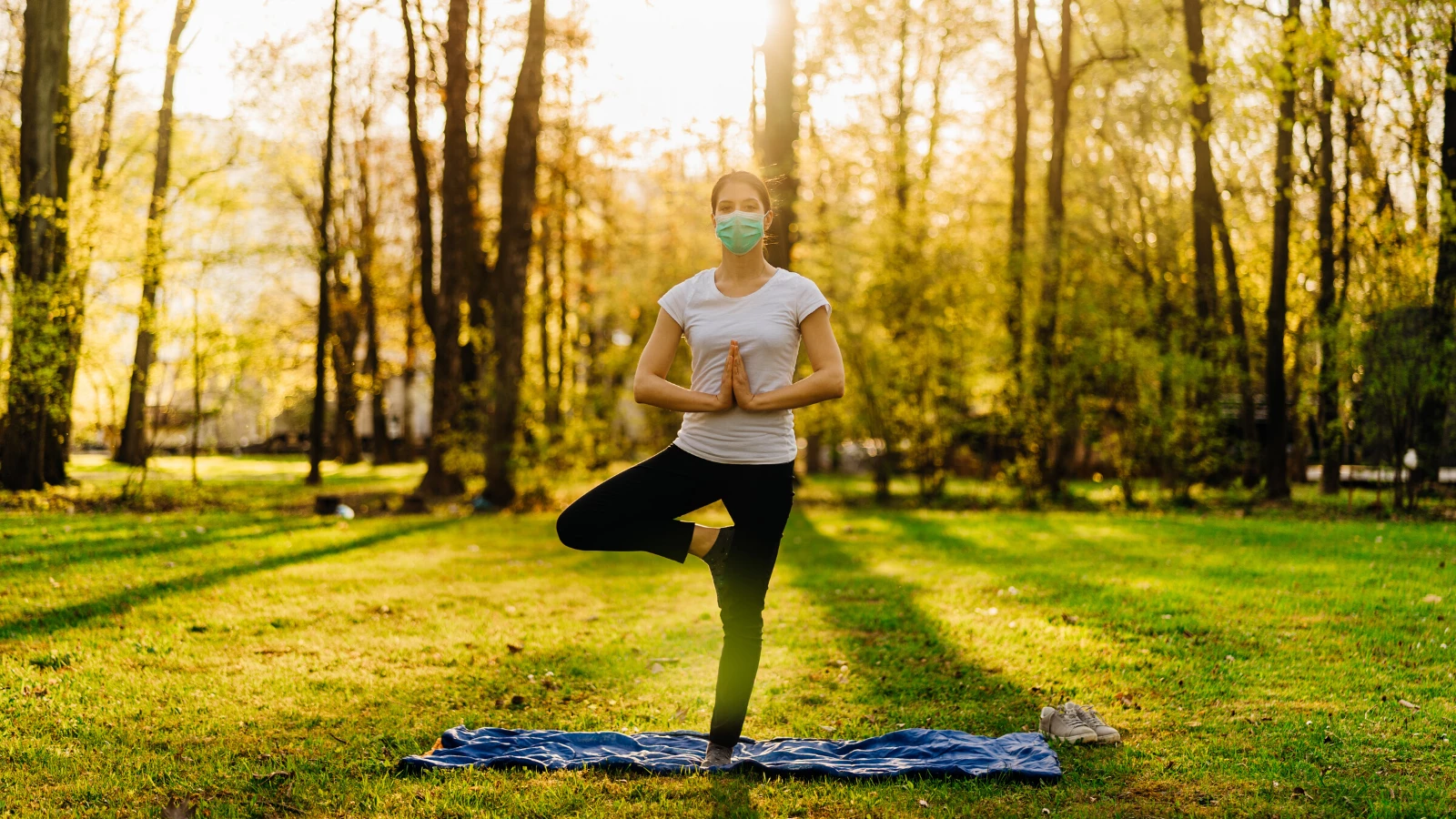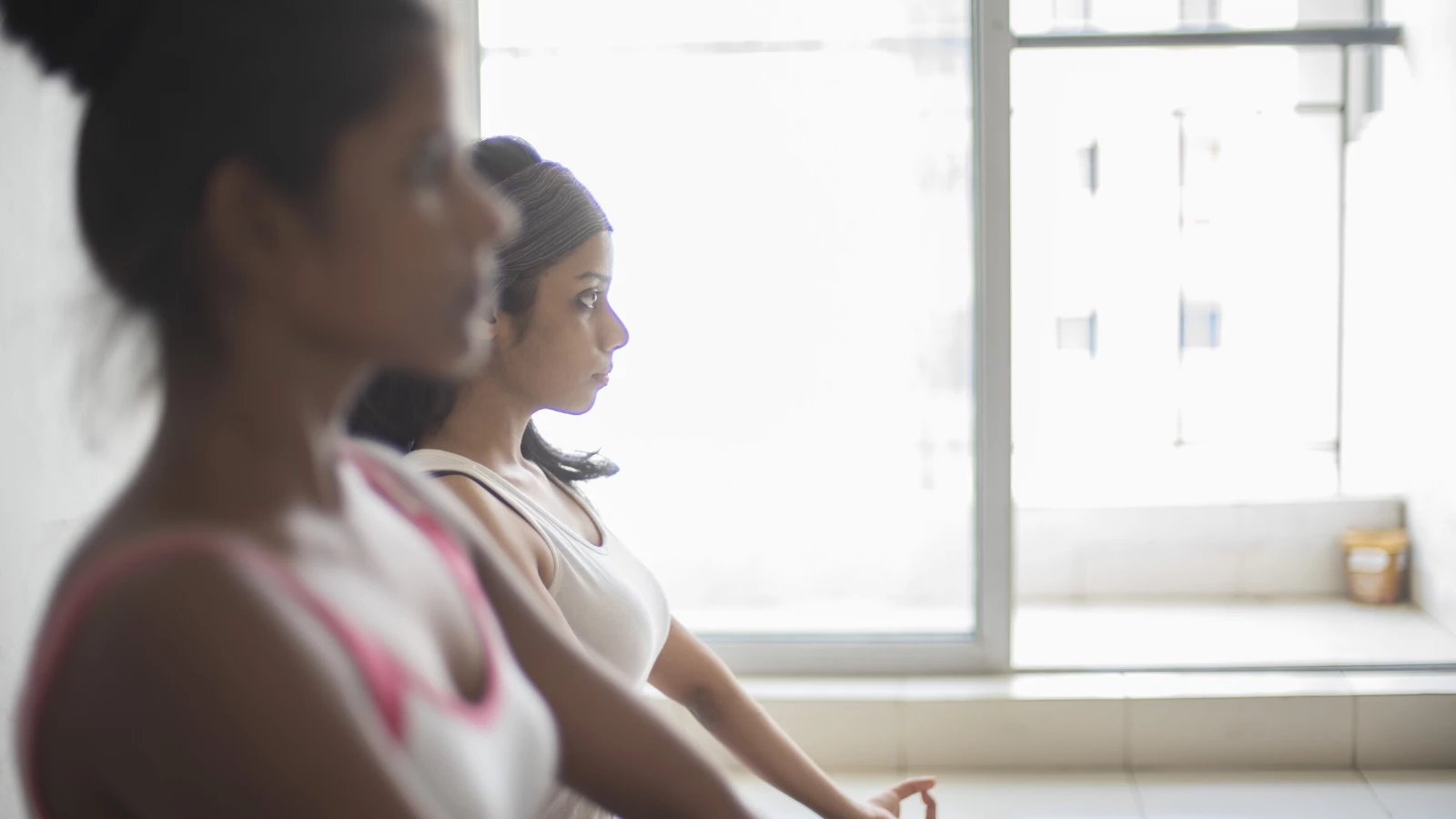Yoga Practice for a Pandemic: 6 Ways to Incorporate Yoga Philosophy into Your Everyday Life

The COVID-19 virus brought the world to its knees. The tumbling economy, cancellation of events, closure of businesses, health concerns, and changes in our daily routine have created fear, anxiety, anger, and other emotional disturbances in people across the globe like never before. While the pandemic is a disaster for the world, one question that is on many people’s minds is if there is anything good that will emerge from this viral disaster.
We can find some answers in the Bhagavad Gita by putting ourselves in Arjuna’s shoes. Just before the onset of the Kurukshetra war, Arjuna loses his courage at the thought of fighting and killing his own kinsmen. Arjuna implores his charioteer, Lord Krishna, “What is the outcome of all this suffering, killing and death, will there be anything good from this war?”
The dialogue between Krishna and Arjuna is the essence of the Bhagavad Gita. Krishna advises Arjuna that his focus needs to be only on the actions, fighting the war, without any thoughts of results—good or bad. Remaining open to success or failure while performing actions, or the quality of equanimity, is an important aspect of human existence. Cultivating this equanimity in our daily lives by active engagement together with accepting the outcome allows us to do our work and be at peace with the results.
Based on this lesson from the Gita, and focusing attention on the pandemic situation that is filled with suffering, pain, and death, let us be mindful of another aspect of humanity that is on display during this time, and which defines several aspects of yoga philosophy. This may be obvious to people who have cultivated equanimity in their daily lives.

1. Karma Yoga (Selfless Service): According to yoga philosophy, Karma yoga is acting selflessly in the service of others. Selfless service and the importance of giving back is the prime essence of Karma yoga. Through selfless service, we also cultivate compassion without any expectation. Turn your attention to the world and you will hear countless stories of how the necessities from this dreaded infection have brought out the best in humanity. We have become more caring and everyone is yearning to help in some form. Anyone wanting to know about practical Karma yoga can draw their lessons from these altruistic heroes who have defied the dangers of the virus and are working courageously to help and save mankind.
2. Ahimsa (Nonviolence): Ahimsa is one of the yamas in Patanjali’s Yoga Sutras. Himsa means violence and is defined as the intentional use of force or power on self or against another living being, resulting in physical and/or psychological harm. (The prefix “a” means “non.” Therefore, adding it to himsa means changes the meaning to “nonviolence.”) While there is still a debate about the origins of the virus—was it a Wuhan wet market selling live and butchered animals or was it COVID-19 virus jumping from bats to humans through meat consumption?—it has definitely raised awareness about preserving our wildlife, birds, and animals in general. Birds, animals, and insects play a monumental role in the ecosystem in which all of us live, and humans are directly dependent on the contributions of these species. Following the virus attack, people are more vigilant about peaceful coexistence and are taking steps to not endanger the birds and animals. There are several discussion forums about techniques to conserve these species and protect their habitats, including forests, trees, plants, and other wild places.
3. Saucha (Cleanliness): While this niyama calls for cleanliness and purification at the level of both body and mind, thanks to the virus, people are now more attentive to the importance of hygiene and cleanliness of the body. All they need to do now is cultivate pure thoughts to bring clarity and purity to the mind, and thereby foster equanimity.
4. Svadhyaya (Self-Study): One of the five niyamas, svadhyaya actually means the education of the true self or self-realization of your true nature. In the present scenario, a lot of online book clubs have been established and a lot of people are joining these book clubs and exchanging information mostly about good health and wellness. Whatever the nature of the study groups may be, self-study and realization do help the mind to become clear and develop deeper mind/body awareness. The path to self-study is also through introspection and contemplation of our own life’s lessons. When we reflect on our flaws and allow our mistakes to serve as learning lessons, we have the opportunity to grow. Thanks to our current isolation and being indoors, many of us are practicing more than the usual self-study that helps empower us.
5. Maitri-Karuna (Lovingkindness): In the yoga sutras, maitri-karuna (aka metta) is defined as tender, soft, good-natured, pleasant, cheerful, and kind-hearted among others. Thanks to the virus, we are witnessing exceptional acts of lovingkindness in numerous scenarios. Basically, the term “lovingkindness” connotes a deep sense of respect, appreciation, and regard. This can be witnessed as an act of compassion, an intention to mitigate suffering and lighten the sorrow. At the core of this trait is the desire to be happy, peaceful, and selfless and extend that peace and happiness to others.
6. Viveka (Practical Self-Realization): At the highest level, practical self-realization is about knowing and recognizing our true nature. At the micro-level, thanks to the crisis and the social distancing, it has allowed us to witness something profound: our desire to be connected with one another. An example that comes to mind is how Italians sang together from their separate apartment windows in a show of national solidarity when the virus was ravaging the Italian population. These events have helped us to think about how we relate to ourselves and to others. This introspection of our own self and our relationship to others allows us to become a better partner, sibling, son, daughter, teacher, or friend.

In summary, thanks to the virus, we all agree that there is no shortage of empathy, lovingkindness, and heroism as the world battles this novel virus. While much of it is happening behind closed doors of hospitals and senior living homes, some of these virtues are also on display outside for all of the world to see. Thus, the boundaries we create are only artificial; we, as a species, are interconnected and dependent on each other. Just as yoga philosophy professes.
Also, read...
Warrior I Pose: 5 Strengthening Variations
Deepening Your Home Yoga Practice: An Interview with Judith Hanson Lasater
4 Easy Ways to Use a Sandbag in Yoga Practice
Related courses
Breath as Medicine: Yogic Breathing for Vital Aging
Yoga and Myofascial Release: Releasing Chronic Tension with the Bodymind Ballwork Method

Rammohan (Ram) Rao comes from a family of Ayurvedic practitioners and Vedic teachers in India tracing back to the illustrious Vedic-acharya Rishi Kaundinya (although Ram admits he cannot do the Eka pada or Dwi pada Kaundinyasana). With a doctorate in Neuroscience, Ram was a Research Associate Professor at the Buck Institute for Research on Aging. He focused on various aspects of age-associated neurodegenerative diseases with an emphasis on Alzheimer’s disease. In addition, Ram completed the academic training at the California College of Ayurveda (CCA) and received his certification as a Clinical Ayurvedic Specialist. He has been a faculty member of the California College of Ayurveda and teaches in their Nevada City location. Ram is also a dedicated Hatha yoga practitioner and is a Registered Yoga Teacher from Yoga Alliance USA. In his spare time, he offers consultations in YAMP techniques (Yoga, Ayurveda, Meditation & Pranayama). Ram has published several articles in major Yoga/Ayurveda magazines and has been a featured speaker in several national and international meetings and symposia. He is a member of the National Ayurvedic Medical Association (NAMA) and is on the Research Board of the Association of Ayurvedic Professionals of North America (AAPNA).



